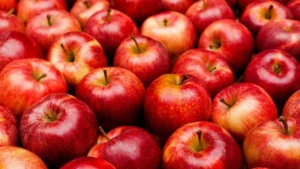Table of Contents
Fall Fruits: A Guide to Seasonal Produce in Autumn
Farmers’ markets come alive in the fall, offering a rich variety of seasonal produce and decorative items like pumpkins, mums, and gourds. But aside from well-known fall vegetables, what fruits are in season? This guide will walk you through the top fall fruits you should seek out, and how they can enhance your diet.
Why Seasonal Fruits Matter
Eating seasonally not only offers fresher, more flavorful produce but also provides a range of health benefits, thanks to the nutrients these fruits contain. Whether it’s antioxidants, fiber, or essential vitamins, seasonal fruits deliver a potent punch of nutrition that your body craves, especially in the cooler months.
Top Fall Fruits to Include in Your Diet
1. Apples

#image_title
Apples come in thousands of varieties, but the most popular types like honey crisp, macintosh, and fuji are available from late summer to late fall. Apples are a fantastic source of fiber, making them a great snack for on-the-go. They also last long when stored in a cool, dry place. Try them in pies, sauces, or simply enjoy them raw.
2. Pumpkins
Pumpkins, although often associated with decorations, are actually a fruit. High in vitamins C and A, pumpkins are rich in antioxidants and dietary fiber. Store them in a cool place for up to four months, and use them in pies, baked goods, or even savory dishes.
3. Pomegranates
Pomegranates are known for their juicy seeds, which are high in antioxidants and vitamins such as K and C. Add them to salads, yogurts, or enjoy them on their own as a healthy snack.
4. Cranberries
Cranberries are harvested in mid-to-late fall, especially in the Northeast United States. They’re packed with anthocyanins, quercetin, and vitamin C. Fresh cranberries are often used in sauces, pies, and trail mixes, though many people prefer them dried or sweetened.
5. Grapes
Grapes are available in a variety of colors like red, green, and black from late summer through early fall. Rich in antioxidants, grapes support longevity and cardiovascular health. Enjoy them fresh, dried as raisins, or added to salads or meat dishes.
6. Kumquats
Kumquats are small, citrus-like fruits that can be eaten with their peel, offering an extra boost of antioxidants. Available in warmer climates during the fall, they’re perfect for juices, tarts, or even enjoyed raw.
7. Passion Fruit
Passion fruit is another fall favorite that thrives in warm climates. Its sweet-tart flavor and aromatic juice make it a great addition to smoothies, drinks, and acai bowls. Passion fruits are rich in antioxidants and vitamins like A and C.
8. Guava
Guava is a tropical fruit that peaks in fall. It’s high in vitamin C, copper, and lycopene, a powerful antioxidant also found in tomatoes. Use guava in fresh juices, cocktails, or as a topping for yogurt bowls.
9. Persimmons
Persimmons are available in late fall and provide vitamin A, C, and manganese. Their thin skin is edible, and they make an excellent addition to desserts like tarts or enjoyed raw as a snack.
10. Quinces
Quince is a lesser-known fruit available in the fall. High in fiber and antioxidants, it’s best enjoyed when boiled and used in purées, tarts, or juices.
Additional Fall Fruits

#image_title
Besides the popular fruits listed above, you may also find fruits like lemons, limes, kiwi, bananas, and figs in markets during the fall.
The Benefits of Seasonal Eating
Why should you prioritize seasonal fruits in your diet? Not only are they more nutrient-dense and flavorful, but they’re also usually more affordable and have a smaller carbon footprint. By eating seasonal, you reduce the need for long-distance transport, thus lowering your environmental impact.
Health Benefits
- Higher Nutritional Value: Seasonal fruits like cranberries and kumquats are high in vitamin C and antioxidants, which support immune function and combat free radicals.
- Better Digestive Health: The fiber found in fruits like apples and pears supports gut health, helps with weight management, and balances cholesterol levels.
- Improved Cognitive Function: Antioxidants in grapes and pomegranates have been linked to enhanced brain function and reduced cognitive decline.
- Heart Health: Fruits rich in antioxidants, such as pomegranates, help regulate cholesterol and blood pressure, reducing inflammation and supporting cardiovascular function.
How to Incorporate Fall Fruits into Your Diet
Fall fruits are incredibly versatile and can be incorporated into a wide variety of meals. Here are some recipe ideas to get you started:
- Gluten-Free Pumpkin Bread
- Apple Cinnamon Muffins
- Beet and Pomegranate Salad
- Grape Jelly Meatballs
- Apple Galette
Risks and Side Effects
While fruits are generally healthy, it’s essential to consume them in moderation. Most people can benefit from one to three servings of fruit per day. When shopping, opt for organic fruits to minimize pesticide exposure. Store fruits properly to prevent spoilage and bacteria growth.
Conclusion
Fall offers a wide variety of fruits that not only taste great but also provide numerous health benefits. From apples and pumpkins to persimmons and pomegranates, incorporating these fruits into your diet can help improve digestion, support heart health, and boost your immune system. Eating seasonally ensures you’re getting the best taste and nutrition while reducing your environmental footprint.